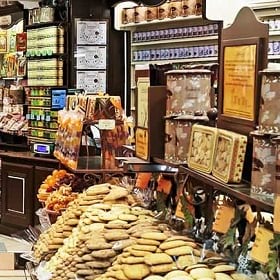How Data-Driven Commerce Is Driving Retail
Retail executives can commiserate over apocalyptic headlines—or they can find new ways to drive their business forward. Those who choose the latter have an ally in the fight: data-driven commerce.
The retail industry has spent a lot of time lately looking in the mirror. For some, it’s a fun-house mirror that exaggerates the industry’s flaws, shrinks its strengths, and gives birth to sensational terms such as retailpocolypse. Yes, brick-and-mortar retailing has been disrupted by e-commerce, m-commerce, and other shopping innovations. No, it is not doomed to destruction—even if some brands won’t survive the upheaval.
Amid the din, leading executives see cause for optimism. According to research by Deloitte, 44 percent of consumers spent more on retail in 2017 than they did the previous year. Just 14 percent spent less. Is that any surprise when, for instance, one in six young people say they won’t wear an outfit again once they’ve been seen in it on social media?
The Myth of the Apocalypse
Physical stores account for 90 percent of retail sales in the United States, and shoppers say the in-store experience is important to them. In fact, a 2017 IBM study of Generation Z consumers found that 98 percent of Generation Z consumers favored making purchases in store either most or some of the time. By comparison, 76 percent said the same of online shopping. (IBM defines Gen Z as people born in the mid-1990s and later.)
The in-store experience also remains front and center for more mature shoppers. Seventy-four percent of baby boomers prefer to shop in store, according to a study by Oracle.
And yet consumers aren’t content to shop only in store, and retailers must adapt. Shoppers want the tried-and-true as well as the new: intuitive e-commerce, loyalty apps, same-day delivery, and in-store pickup.
As savvy retail executives improve the linchpin of retail—the in-store experience—they are finding clues in digital data. In its 2018 Fjord Trends report, Accenture noted that “the emphasis [among retailers] is shifting onto how best to use digital as an invisible enabler of physical and sensory experiences.”
Data-driven commerce is at the center of that shift.
What Is Data-Driven Commerce?
Retailers and brands are in the midst of a once-in-a-generation shift, as consumers demand more relevancy from the companies they patronize—rather than just good products at lower prices.
The coming-out party for data-driven commerce is happening at a time when consumers are defining the conversations between themselves and the companies they do business with.
James McCormick, a principal analyst at Forrester, called it “the age of the customer” on a recent podcast. “We’re in this age where the customer’s more empowered than ever before,” McCormick said, “and actually more powerful than the brands when it comes to managing the narrative of the discussion and the engagement with the brands.”
Customers want brands and retailers to talk about things that matter to them and to deliver curated offers that feel tailored just for them. They expect consistent, quality experiences on social media, on their devices, and in stores—a unified conversation for unified commerce.
Many retailers are stumped. Nearly two-thirds of them told Retail Systems Research (report gated) that defining the right kind of conversation to have with consumers is their top challenge. This challenge goes by many names, including getting closer to the customerand creating personalized content.
The answer is in the data.
A company that wants to create relevant messages and conversations must first understand its core customer. This includes knowing what kind of products customers browse and buy as well as what they care about and why they might be loyal to a particular brand. This involves using a form of modern-day psychology that draws heavily on digital data—to find insight on customer groups while respecting individuals’ privacy.
Consider a short list of the data sources that retail executives can use to understand customers and shape conversations:
- Loyalty data from their CRM system
- Point-of-sale transactions and market basket data
- In-store customer movement and product placement analysis
- Demographic and psychographic profiles of consumer groups in certain neighborhoods, cities, and regions
- Direct feedback from social media posts and in-app comments
- Mobile buying and browsing habits
Hidden in this data is the location intelligence that tells retailers who its core customers are and where they reside. Location intelligence is the engine of data-driven commerce, and a geographic information system (GIS) is the brain that produces that intelligence.
With relevant data and tools, a retailer can create the right conversation with customers in the right place, reinvigorate the shopping experience, and drive competitive edge.
(As retail executives mine data for customer insight, they should be careful to avoid the common pitfalls of this kind of analysis.)
Data-Driven Commerce in Action
The scenario of a premium food retailer will help illustrate how data-driven commerce—infused with location intelligence—can deepen a company’s connection with customers and deliver competitive advantage.
This hypothetical food retailer chain has seen slowing sales growth in most of its markets for the past six quarters. Executives suspect that new competition in some of those markets, along with online retailers providing home delivery, has lured customers away. The executives set out to examine the available data to identify root causes, learn about their core customers, uncover better ways to communicate with them, and reignite sales growth.
Their data-driven analysis follows three steps:
- Define the store’s core customers—and what they want from the store.
- Define the market conditions around the stores.
- Identify ways to increase customer loyalty and attract new customers.
To define the store’s core, or best, customers, executives consult several data sources. First, they examine CRM and point-of-sale (POS) market basket information on in-store, in-app, and online purchases. This data helps them categorize customers into tiers based on several metrics:
- Total spend per month
- Number of shopping trips or online baskets completed in the past month. (Total spend isn’t the full story; a frequent shopper who spends $100 a month might be more valuable than one who spends $400 in just one visit.)
- Margins on the products in their baskets (This reveals whether customers buy things at full price, react to promotions, or cherry-pick clearance and low-margin items.)
Analyzing that data across all purchase channels—in store, in app, and online—is a new approach for the company and creates a richer, smarter view of customer patterns.
Once executives have sorted out the tiers of customers based on that data, location intelligence can help the company explore what the core customers care about as well as define the market conditions around each store.
Location Intelligence Yields Customer Insight
Using location intelligence, the company can convert data on customers’ addresses into insight on their tastes—and, ultimately, create ways to communicate with them that feel personalized to their preferences.
Data-driven commerce could be construed as a race to find every last bit of information on each individual, but it’s not. Technologies such as GIS deliver crucial insight on specific groups of customers—while keeping the privacy of individuals intact.
To do that, the company uses a technique called geoenrichment—a method of converting customers’ addresses into insights based on where they live. What sounds like sleight of hand is actually a decades-old process that’s been updated for the digital age. It rests on a simple premise: a retailer’s best customers often share behavioral and attitudinal traits—they may be soccer moms or outdoor enthusiasts, devotees of alternative medicine, or single parents on tight budgets. While some retail executives assume they know who their core customers are, many who use data-driven commerce find that they’ve actually gotten this wrong.
At the premium food retailer, analysts use location intelligence powered by a modern GIS to find insight on customers. Using GIS-based smart maps, the team plots the locations of the store’s best customers, then converts that information into group-level demographic and behavioral data to maintain the privacy of individual shoppers.
The retailer’s executives had assumed that high-earning professionals were the upscale store’s best customers. But income is just a fraction of the equation in understanding the customer. GIS helps the company dig deeper.
Analyzing data based on where customers live is one link in the location value chain—a cycle of insight that helps companies strengthen their connections with core customers.
Location intelligence helps the executives see whether its core customers are the kind of high earners who participate actively in their community and have children of school age or past college. Do these customers value the experience of a store visit, or do they prefer the convenience of home delivery? Are they living in older suburban enclaves, or do they favor denser, more urban settings?
The analytics team documents the core-customer profile for later use and moves on to the next phase of data-driven commerce.
Analyzing Market Conditions around Each Store
The next step in boosting sales involves understanding the trade area around each store. Most regional and national retailers study this information as they plan new locations—scouting potential customers and analyzing competitors. But it’s an exercise that must be repeated to be effective long term.
To establish a store’s trade area, the gourmet food retailer analyzes a combination of in-house and third-party data. POS and CRM systems provide information on existing customers, while software such as GIS delivers insight on customers as well as would-be shoppers and competitors. Geography provides the key backdrop.
The retailer combines those elements and finds unexpected insight, like the fact that some of the brand’s best customers shop at a location that’s 25 miles from their home rather than one five minutes down the road. This likely means they shop near where they work because they crave a quick in-store experience before they go home for dinner. Gathering that insight helps the company get close to its customers and shape conversations that matter to them.
An equally important feature of the trade area is its competitive dynamics. Here the company combines its executives’ industry knowledge with location intelligence sourced from GIS to see how competitors are growing, where their trade areas overlap the store’s, and where they’re stealing market share.
With a better grasp of its core customers’ motivations, the company’s C-team can infer why these customers are migrating to the competition. Are competitors opening stores where high-earning professionals spend their workdays? Are these competitors offering better unified commerce options to complement customers’ demanding schedules?
With that knowledge in hand, the gourmet retailer moves to the next phase of data-driven commerce: taking action.
Improving Relationships with Customers and Prospective Customers
With the insight generated by data-driven analysis and location intelligence, the retailer can take action to improve sales and plot a trajectory for long-term success. The actions take many forms:
- The store’s marketing managers appreciate the data-driven view of their best customers. With stronger insight into those customers’ interests and geographic locations, the team begins to create messages that resonate more with core customers, delivering those messages in the right locations through location-based advertising.
- GIS-based maps of the store’s traffic flow reveal that shoppers tend to bypass high-margin items, prompting store operations executives to consider alternate layouts and in-store promotions.
- The demographic profile of the store’s best customers shows that they aren’t drawn to home delivery—they work long hours and aren’t home during the day to accept perishables. But they do value efficient in-store pickup. The fulfillment team begins work with store managers to increase staff to handle more orders, and coordinates with the marketing team to advertise pickup options.
- With greater visibility about what drives core customers’ purchases, a tiger team initiates several in-store adjustments: a greater selection of free-trade products, more in-store demo booths for up-and-coming brands, and a digital newsletter that focuses on community events.
- Mindful that their core customers expect always-on customer service, executives add a live help button to the store’s app. When shoppers push the button, the GIS-based app locates them in the store and directs the closest store associate to them to assist.
Across the spectrum of retail operations, data-driven commerce delivers customer insight and location intelligence that retail executives need to personalize shoppers’ experience. Forward-looking business leaders have sworn off reading apocalyptic headlines. They’re now using data-driven commerce to turn disruption into opportunity.











